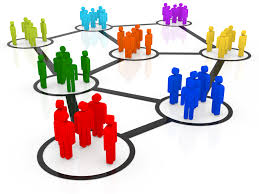Yes, you do need to network!
In some countries people are introduced or placed by friends and family into jobs or brought into a business. In other countries, graduates find their first jobs because they are automatically placed by an educational institution, government, union or industry association. But in Canada, you absolutely need a business network both to get work and to start and sustain a business.
Even people who are born here don’t usually understand how important networking is to their economic success, and if you are in school, recently graduated, new to your city, province or country, I can guarantee that your network needs help.
On principle, networking is fairly simple and it works like this: you look for events, groups of people or individuals who are part of the business or organization you want to be a part of using professional and industry associations, industry events, networking events, and social media sites like LinkedIn, Facebook, Twitter and Meetup. Once you start making contacts, you focus on building up a “rolodex” of people you can call or email for a variety of professional reasons.
Building your network takes just that – work – and it has to be sustained. BUT the “net” effort you put in creates a web of mutually beneficial relationships. These relationships both give and take in ways that fulfill an essential function: helping people achieve their career goals.
You can build networks physically and virtually, but at the end of either is a real person and that is what you need to remember.
Network Benefits

A good network has these benefits:
- If you have a question you can find an answer fast and it is usually a good one
- If you need advice, someone you respect will be there for you
- If you need a job, a client or a way in to a group, your network will provide it
- If you want to switch jobs, buy a business or sell yours, the network will pitch in
- If you have services and products your network will recommend you
- If you need a reference, contact your network
- If you are worried about your sales – get the network to champion you
In a good network, others will also depend on you for the above. But don’t worry, nobody needs everything at once, and you can always say no. Just remember that what you do for your network, your network will do for you. It is a mutually beneficial relationship.
Three cups of tea
There are three basic circumstances where you will find yourself – or consciously place yourself – into a networking situation: informal one-on-one meetings, small group meetings, and networking events. Each circumstance requires a slightly different approach. But all networking has a particular order that needs to be respected. That order is, as they say in Afghanistan, the principle of “three cups of tea” – basically you have to have three interactions with someone before they will “trust”, “buy” or “hire.”
Let’s see how this principle applies using three different circumstances:

1) Informal one-on-one: This can happen anywhere. You are in a grocery or movie line up or a coat check line up and you chat with the person in front or behind you. Or you know someone who introduces you to a friend and you strike up a conversation. Or you meet a someone while having your morning coffee and you decide to set up a meeting with them.
The key to this kind of networking is that you take the time to ask the other person questions and get to know him or her, find out about his or her job, business and interests. Next you move to a question about challenges the individual or organization might face. This is your “first cup of tea”.
If you see an opportunity to match the problem with a service or product you have to offer, you could offer it then. But usually that is too soon. It is often better to have a second meeting or phone conversation that involves you giving something to the other person. Once you have done that, you have established trust. For example you might share an article that you found helpful, send a product flyer over or connect the other person with one of your contacts. That is your second cup of tea.
If that interaction has gone well, then you should make “the ask” for what you are looking for. This is your third cup of tea. If the person does not or cannot give it to you, ask them for a recommendation to someone who could help you. Or ask them if you can keep them on your “experts” list or newsletter list.

2) Small group: In this networking opportunity you are in a meeting, at a round table discussion or at a small gathering somewhere. Certainly hand out business cards if you would like to, but expect to get the most benefit from figuring out who your most likely connection is from the conversation you have been having with the group – there will likely only be one or two. Try to break off to a side conversation with this person or these people and go through the steps from the first scenario. That is your first cup of tea.
Another way to approach this opportunity is to listen for a common need that may arise from the group’s conversation. For example, if everyone is talking about how they are having trouble staying focused when they have too many tasks, you could suggest a great productivity app you have been using. Perhaps offer to show it to the group or send them the name of the app through their phones. Alternatively, if you find you can give the group the opportunity to share their knowledge with you, ask them about the products they use or the knowledge they have on a subject of interest to you. This is your second cup of tea.
The third cup of tea will be served if you can meet with your new contact over the phone or in-person. Here you can again make “the ask” because you have been able to assess how exactly this person might be able to help you reach your career goals.

3) Networking event: These events are usually noisy, have lots of things happening and have food that is buffet style. You need to modify your three cups of tea principle to suit the environment and here are some suggestions to help you with that:
First you might need to meet several people before you actually find someone you want to continue the exchange with. Of course, be polite to the people you leave behind: say it was nice to meet them and that you enjoyed your chat, then leave them with your business card with a little note written on the back to remind them who you are (like “The productivity app person”).
Second, getting food or a drink is a perfect opportunity to either excuse yourself or to interact with someone for the first time. Introduce yourself, shake hands firmly, smile (men remember this please) and ask something like, “What brings you to this event?” or, “How are you enjoying the event so far?” or, “Have you attended this event before?” This will get you off to a good start and serve your first cup of tea.
The key thing to remember is to show interest in the other person – I can’t stress this enough – and ask questions. Once you have asked a few questions, do volunteer some information about yourself. People are suspicious of those who ask but never share. And the people who won’t stop sharing are problems too.
For more ideas on how to manage networking events, check out our FREE DOWNLOAD: Networking for shy people
Because large networking events are meant to keep people moving from group to group, you don’t have much time to make an impression and you have two desirable options: leave a strong positive impression or (and this is more controversial) leave them with a challenge. Ask them to share where they got their information from or offer an opposing viewpoint. People often remember those who challenge them, and even if they didn’t like the challenge or like you, they will nonetheless respond positively to your second “cup of tea” when you contact them.
What’s important is that you make yourself memorable and that you give the other person the same opportunity. As in the first and second scenarios, the third cup of tea happens as an in-person or over-the-phone conversation and this is where you make “the ask.” Be bold and don’t miss your opportunity.
Trade show booth networking
If your large networking event is a trade show all these principles apply, but there are a few differences. If you have a booth at a trade show, it is common to attract a bunch of lonely people looking for love or to be a magnet for know-it-alls who can’t wait to share all their “wisdom” with you. It is important to politely disengage yourself from these people while thanking them for coming to see your booth. If you allow yourself to be dragged into these long conversations, you will miss the people who would be likely leads because they won’t wait forever to speak with you.
The advantage of the trade show booth is that people come to you so you don’t have to find them, though it is wise to attract them with a door prize draw, an easy question like “How are you finding the event?” or a direct “Would you like to see a demo on…?” This is your first cup of tea.
The second cup is served when the people come back to your booth for more information to just to chat. Now it is your role to find a third way to connect them to your service, product, card or to introduce them to the people in the booth next to you (everyone will love you for that – remember to think of your booth neighbors as potential network people too). And here are the three reasons the individual will remember you when you send them the follow up email or phone call.
Following up and staying in touch

Now you have found some warm contacts but if you want the networking relationship to progress (and trust me, you do), then you need to follow up. If you don’t email and phone you will likely have no response; if you only email or only phone, you have half a chance; if you do both up to three times (three offerings of “tea”), you will have the best chance. Always be polite and respectful of people’s time. They are not obligated to meet, help, buy from, or hire you. On the other hand you have something important to offer them that will meet their needs, so you aren’t wasting their time.
The next part of maintaining those relationships is is staying in touch now and then. It’s best to stagger your follow up interactions so you stay in people’s memories without becoming a pest AND it makes it more sustainable for you. Send articles, product information sheets or event invitations to people you think would find them useful. Avoid blanket emails unless you have a big announcement to make. Instead be selective and personalize your interactions. This is all part of sustaining your network.
In Review
To recap, all networking involves “three cups of tea,” or three interactions with a person before any meaningful connection will develop between the two of you OR the people they introduce you
Remember the following tips as you begin connecting:
- The people you meet are real: they have feelings, intelligence and skills and you should always be respectful
- Asking more than you tell and offering to do something for the other party establishes trust and helps you be seen as a valuable person to connect with
- Extend your “ask” in the third interaction or you may lose your opportunity
- If you are at a trade show, remember to focus on finding those who you can help and those who can help you
Happy networking! (And remember me when you reach your career goals!)







